Rap and hip hop are more than just types of music; they are ways of life. Hip hop is a style, an outlook, a way of acting and being that includes a confident yet laid back attitude. Hip hop incorporates many styles of music, and the history of its origins is both surprising and unique.
Hip hop was brought to life by one of the first DJs, DJ Kool Herc. He moved to New York City from Jamaica and brought with him the elements of “toasting” at parties, a tradition from the Jamaican Dance Halls.
When he combined this with the dual turntable set up from disco clubs, hip hop was born.
In the article below, we will dive deeper into the origins of hip hop, rap, the difference between them, and the influence that these industries have had on our culture today.
Table of Contents
DJ Kool Herc
The man most commonly touted as the father of hip hop goes by the name of DJ Kool Herc.
Born in Jamaica as Clive Campbell, he grew up amongst the vibrant local culture. This included the Jamaican Dancehall scene, which was a movement all on its own. In Kingston, Jamaica, in the 1950s and ‘60s, many physical dance halls existed.
These were places that the marginalized groups would go and celebrate their cultures. Locals would load up these big rooms and courtyards with giant speakers, and play lively records of ska, reggae, mento, and rocksteady genres.
Hosts of these parties would provide the crowd with entertainment, and this key element, known as “toasting,” would become very influential in the future of hip hop.
Herc Meets New York City
When Herc was 13, his family left Jamaica and moved to New York City. When he arrived in America, he found a lot of abandoned television sets and vehicles on the streets. He collected the parts from these electronics and made his own small speaker boxes in his room.
Over the next six years, Herc spent hours in local community rooms and disco clubs. He studied how people danced, spoke, and connected. As Herc’s passion for dancing grew, so did his distaste for DJs who couldn’t seem to mix their beats right.
Every time a DJ would transition between records too abruptly, or steal the break of a song, the crowd would be outraged and deflated. Herc learned the valuable lesson that the breakbeat of a song is often the crowd’s favorite part.
DJ Kool Herc Is Born
When Herc’s sister wanted to make some money for back to school clothes, Herc DJed for her at the local youth community center. They charged $.25 entry for girls and $.50 entry for boys. This successful party made history as one of the first moments that DJ Kool Herc helped to define hip hop.
It was after this that Herc went on to DJ in many of the community centers in the Bronx, packing the rooms full of his young fans. Once his crowds got too big, he had to switch to bigger venues like the now-extinct Executive Playhouse on Jerome Avenue.
How Herc Shaped Hip Hop
During these early years of playing the clubs on Jerome Avenue, Herc made many improvements to the ways the DJs had been playing. These small changes ended up developing into some of the keys parts of hip hop today.
One of his main contributions to the genre was his realization that people love the instrumental parts of songs. Dancers would hit the floor the hardest when these beats would happen, and so Herc wanted to extend that feeling and those moments.
He bought two copies of the best records and played them side by side on dual turntables as they did in the disco clubs.
The key to Herc’s brilliance is that he would line up the instrumental beat of the two discs end to end, so he could switch back and forth between the records and keep the breakbeat going for as long as he wanted.
This was the earliest form of what would become known as looping, a staple of hip hop and DJing.
Herc called this the Merry-Go-Round, as the beat never stopped. James Brown’s “Give It Up or Turnit a Loose” was one of Herc’s favorite songs to do this with. It was a #1 R&B hit of 1969, which made it a crowd-pleaser in the clubs.
By uniting the toasting the elements of Jamaican Dancehall Music and the dual-turntable style of DJing from the disco clubs, Clive Campbell gave the world one of its most beloved music styles, hip hop.
Breaking Down Hip Hop
Hip hop and rap are often thought to be interchangeable terms. When considering music alone, they certainly have many similarities. Both are usually upbeat, with heavy elements of bass and strategic snares.
These catchy elements meant both styles of music gained popularity at parties. The components in common, however, do not mean that they are one and the same.
Technically, rap is a type of hip hop. Meaning that while all rap is hip hop, not all hip hop is rap.
Rap is more commonly understood as a genre of music, while hip hop historically was a cultural movement. Rap is one of the four main elements of hip hop. We’ll take a closer look at these components below.
Tagging
Tagging, or the first version of what evolved into graffiti, began in Philadelphia in the early sixties with the presence of two city-scrawlers named Cornbread and Cool Earl.
This early form of graffiti was most often the tag of an individual’s name on a location, representing a sort of declaration of their presence in the neighborhood.
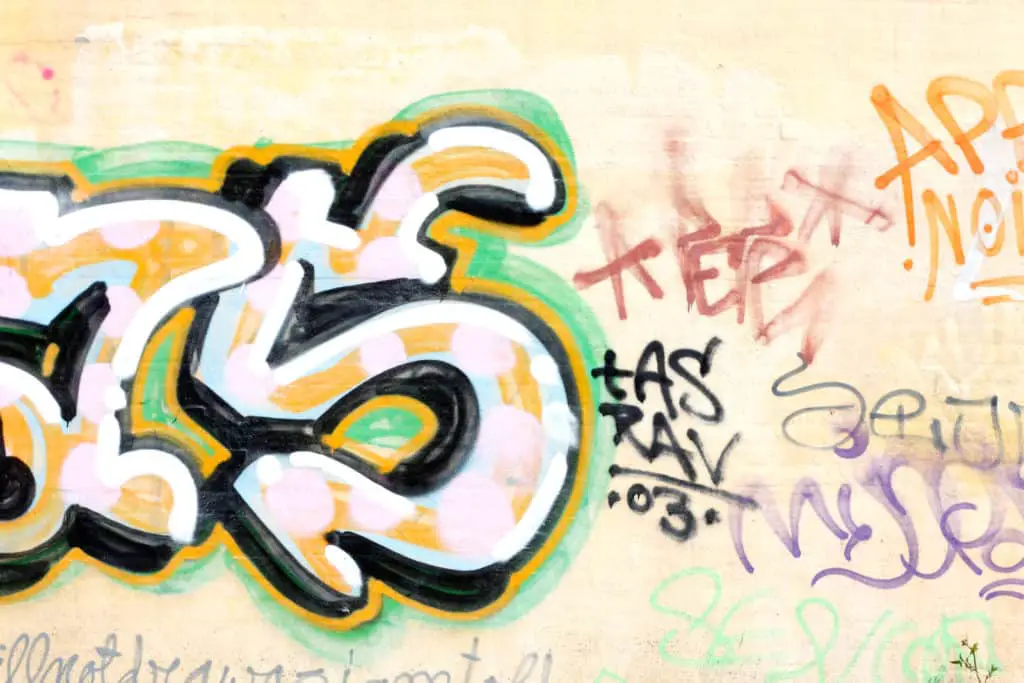
In the summer of 1971, The New York Times wrote an article about a graffiti artist named TAKI 183, who had been tagging the city relentlessly. This brought tagging and graffiti into the limelight, helping it become widespread.
Though it is hard to pin down the exact point of overlap between hip hop and tagging, the general belief is that the fans of one were so often drawn to the other, that they quickly became intertwined. DJ Kool Herc himself started as a tagger before moving to DJing.
B-Boying
B-boying, or breakdancing, came again from DJ Kool Herc. He realized while watching people dance and party that the best dancers in a crew would wait out the song until the instrumental beat happened – what’s called the break.
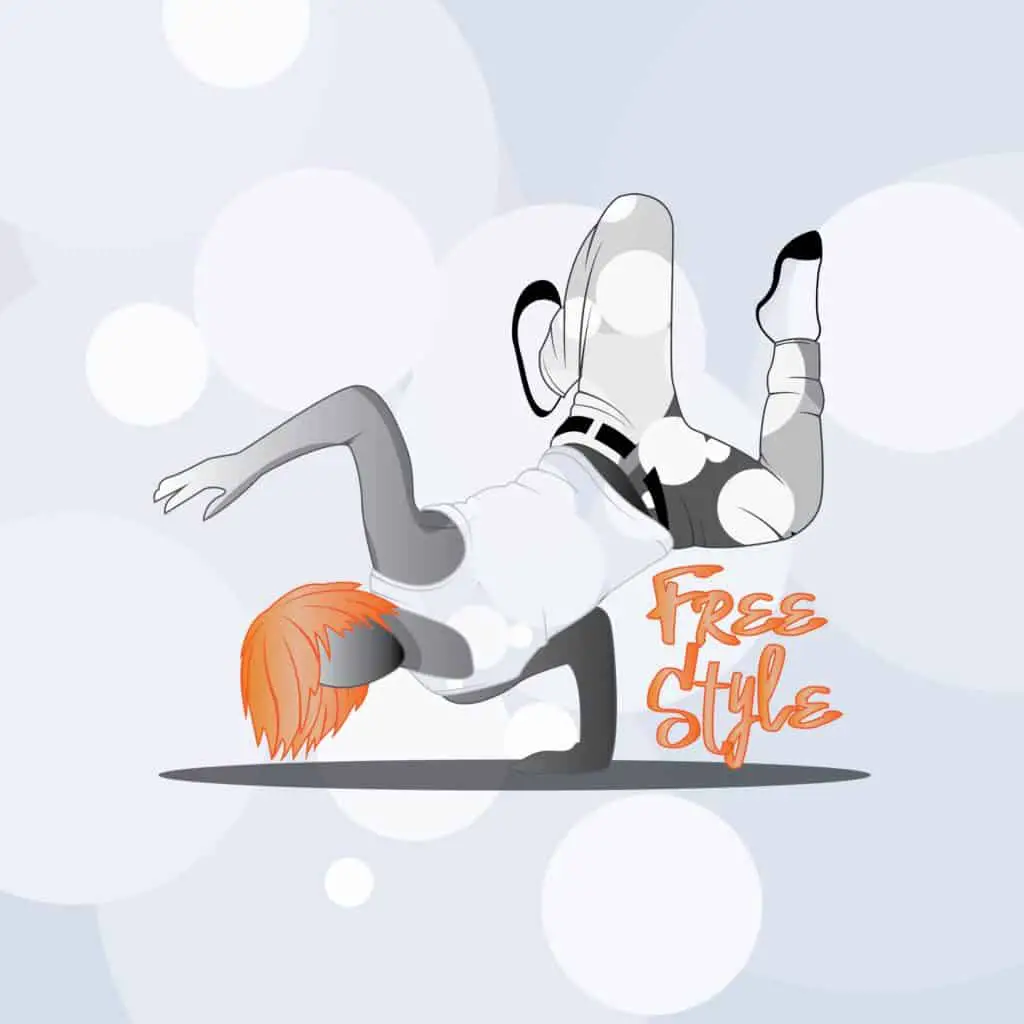
Herc found a way to extend this section of the song on a loop, creating live music that was a favorite of these people who wanted to dance during the break or breakdancers.
A huge part of hip hop is heightening the levels of cool in something, and this often came in the form of shortening words, so breakdancers became “B-Boys.”
MCing/Rapping
An MC, or a Master of Ceremonies, is the host and backbone of a live event. They usually provide welcome and goodbye speeches in the timeline and introduce all guest speakers and acts throughout the day or night.
The MC became a figure in hip hop at about the same time that DJ Kool Herc came on the scene. Bringing inspiration from his Jamaican origins, he used the same basic elements of the Jamaican Dance Hall.
These big parties would have a host or MC who would “toast” to the acts and the crowd throughout the night, usually in witty, rhyming lines.
The main job of the MC was to entertain the crowd, provide smooth transitions between acts, and keep the energy of the room up.
As MCs became more and more popular at shows in New York City, the way in which they entertained the crowd transformed.
The introductions for different DJs and acts became longer, and the MCs filled those spaces with rhyming phrases, thought up on the spot. This first version of freestyle quickly grew and became one of the first popular versions of rap.
Rapping became such an integral part of hip hop, that entire shows would be formed around watching two rappers “battle.” There would be another MC who would host these events. He would introduce the rappers and guide them through each round of the battle.
As with rapping and MCing, the ingredients of hip hop often overlapped.
DJing
The fourth and arguably most important element of hip hop is the DJing. It involves mixing between, traditionally two, records, to create a flawless playlist that keeps the spirit of the party high.
The DJ sets the mood for the event, choosing the tempo and tracks suitable for the crowd. In the beginning, and even still, some DJs acted as their own MCs. Once MCing turned more into the fully-involved rapping, DJs focussed back onto their own beats, chiming in once in a while as an accent on a track.
Grandmaster Flash
Kool Herc brought many integral pieces of hip hop to the scene, shaping the genre in ways that serve as the pillars of hip hop. But he wasn’t the only one on the scene.
Grandmaster Flash, another early DJ and pioneer of hip hop, contributed in many ways to the movement. He also played in the Bronx, spinning records at outdoor parties in the suburbs of New York City.
Arguably, his biggest contribution to music was the introduction of record scratching. This involves physically moving the record back and forth on the turntable, to produce the “scratching” sound effect that universally signifies hip hop.
Because the needle stays in the track of the record, no actual damage was done to the discs, but it made an infectious and unique sound that got the crowds’ attention.
It was so attention-grabbing in fact that the crowds would stop dancing and simply start to watch Grandmaster Flash at work. This was not something Flash was interested in. He wanted the crowds to dance and have a good time.
He invited his good friend Keith Wiggins on stage to help him keep the crowds focused on the party, not on the DJ. Wiggins began delivering spoken words and phrases over the beats.
This was another natural occurrence of rap in hip hop, and some argue that this is the original source of both.
You can see how important scratching has remained in the rap world, one of my personal favorite rap influenced scrap DJ’s has to be Mix Master Mike. Watch the video below and prepare to be amazed 🙂
How Hip Hop Evolved
Over the next ten years, DJs like Grandmaster Flash and Jazzy Jay helped to refine what was becoming known as hip hop.
Hip Hop in the 70s
In the late 70s, DJs began recording their beats and rapping over the top of them, creating and releasing new records altogether.
1979 marked the year that The Sugar Hill Gang’s “Rapper’s Delight” was released. This catchy tune used the popular disco song “Good Times” by Chic as the backing track. It was both instantly recognizable and totally new all at once.
The song quickly gained in popularity, breaking through into the charts as the first-ever hip hop track to land on the Billboard top 40. This was a major turning point for hip hop.
Before this, hip hop was a live event– it could only really be experienced in person.
With the release and following popularity of actual hip hop tracks, it finally made the jump out of the streets of New York City and took North America by storm.
Hip Hop in the 80s
As hip hop entered its second decade of existence, it reached new heights in pop culture and saw the invention of the Roland TR-808 Rhythm Composer. This drum machine allowed users to create unique beats instead of only sampling and altering other beats.
The commonly known 808 was part of the reason why hip hop started leaning into such an electronic direction. Another leading factor in this change of style was the single “Planet Rock” by Afrika Bambaataa and the Soul Sonic Force.
In the 80s, hip hop saw a large number of songs that include social statements, like Grandmaster Flash and the Furious Five’s song “The Message.” This song made observations and statements about growing up in poverty, instead of simply boasting or toasting like previous hip hop songs had done.
By the late 80s, these social statements were at the forefront of the music, with the easy-going party rap taking a back seat. Hip hop groups like Run-DMC and N.W.A. continued to speak about the way things really were on the streets, finding pride in being able to bring their challenged communities to light.
This became known as “New School Rap,” being harder-edged and less focused on good times than earlier hip hop.
The 80s also saw the introduction of physical human sounds, like beatboxing. This was almost a self-reflection of the genre because many beatboxers made sounds that imitated the drum beats and record scratches of previous hip hop songs.
Hip Hop in the 90s
As new school rap took a hold on the nation in the late 80s, the 90s saw the true development of “Gangsta Rap,” which quickly became the most lucrative genre of hip hop to date.
This type of rap followed in the path of the harsher rap of the end of the 80s, promoting the difficult life on the streets, and at times glorifying it.
This genre of rap was, and sometimes still is, heavily critiqued for romanticizing gang life. It speaks positively and often brags about things like theft, rape, crime, prostitution, drug dealing, and other criminal acts.
Rappers, in defense, claimed that many of these songs were pointing out real issues in inner-city urban areas and that their boasting was merely from the point of view of a character created for the stage.
It was this Gangsta Rap that brought the issues of the rarely-seen ghettos to the forefront of American culture.
While Gangsta Rap was huge in America, the rest of the world was finally getting to know hip hop. In the 90s, National Geographic recognized hip hop as the “World’s Greatest Youth Culture,” stating that “just about every country on the planet seems to have developed its own local rap scene.”
Music Videos and Hip Hop
Once true hip hop singles were created and released in the early 1980s, hip hop music videos followed.
These videos were the perfect way for hip hop groups to demonstrate what they were all about. Specific group styles, neighborhoods where they lived, and faces to the names in the groups were all sharable and glorified in music videos.
These videos helped expedite the spread and success of hip hop by creating iconic moments. N.W.A’s “Straight Outta Compton” showed a realistic view of the streets of Los Angeles, as walked by the hip hop group.
Similarly, the “It Was a Good Day” music video by Ice Cube demonstrated a day-in-the-life of the rapper.
More stylistic music videos developed throughout the 90s, including Tupac’s “California Love,” featuring Dr. Dre. This video featured both rappers as the main event in a dystopian world reminiscent of Mad Max, rapping in a caged dome while the world appeared to be barren around them.
As the culture developed, more attention was given to showy figures in hip hop. This gave way to rappers showing off their gold chains, their grills, their cars, houses, and other riches in their music videos.
This theme stayed as the main vein in hip hop from the 90s, all the way through to 2015. We still see elements of this in today’s rap, but with other forms like Soundcloud rappers introducing some softer emotions into hip hop.
Hip Hop in the 00s
The 2000s saw hip hop develop into the mainstream in ways it had never done before. Reality TV shows like MTV Cribs and Pimp My Ride cashed in on some of the hip hop cultures, turning the rich lifestyles into marketable programs for the masses.
It also saw the fusion of previously separated forms of hip hop. Rappers like Kanye West and Jay-Z found ways to rap about cultural issues, monetary gain, and party lifestyles all on one album.
While the 90s was rampant with rappers from opposite coasts battling for the title of “the best,” the 2000s changed this tune.
The rapper 50 Cent founded G-Unit, not a genre-bending form of hip hop, but one that would blur borders and allow rappers from many different areas of the country to collaborate successfully.
The 00s also brought a massive development of properly structured record labels, meaning artists got the proper funding and steady support of a well-built company, instead of having to rely on the somewhat unreliable income from self-produced records and shows.
Hip Hop and Fashion
From the beginning, fashion was a major part of hip hop culture. When DJs began in the streets of New York City, their main inspiration was still from the disco clubs. The low cut shirts and shiny fabrics transferred over to hip hop.
People who had focused on the other elements of hip hop had other styles. The B-boys wore loose-fitting clothing to be able to spin and move with ease. Baggy t-shirts and caps without brims were popular on the cardboard dance floors.
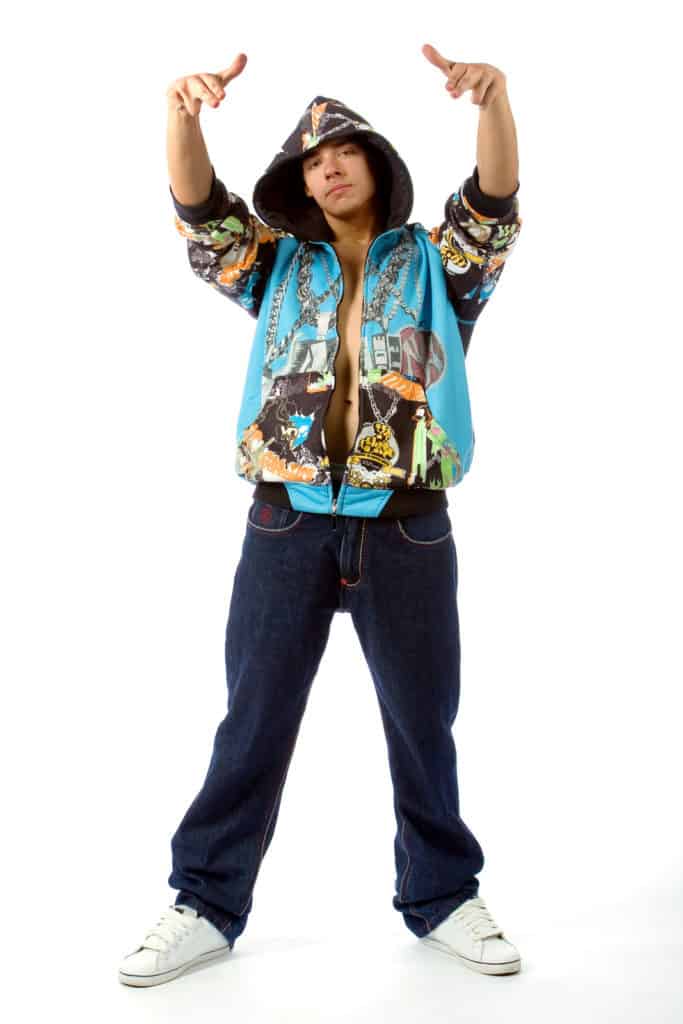
Run DMC brought their own flavor to the hip hop scene, introducing fashion touches that had not previously been seen in hip hop. This included leather vests, black fedoras, oversized chains, and their favorite shoes, Adidas.
They became so synonymous with the brand that they released a song and music video titled, “My Adidas.”
The song was so successful that Adidas took note, and the first endorsement deal between a hip hop group and an athletic company followed.
As hip hop drew from many cultures around the world, so did its fashions. It went through a huge influx of African inspired fashions, especially if they were in the yellow, black, and green of the African flag.
The fashions also drew from sports, like basketball, with rappers wearing oversized basketball jerseys paired with the iconic loose pants.
Famously, hip hop has favored these extremely baggy pants. This is reportedly because, in prison, belts are banned as they can be potentially used as weapons.
Fashion continues to be an integral part of hip hop.
From Jay-Z starting Rocawear, which he sold to Iconix for $204 million dollars, to 50-Cent teaming up with Ecko to launch G-Unit Sportswear, to Kanye West collaborating with Nike to release the Yeezy shoe line, it’s undeniable that fashion and hip hop have become intertwined.
Hip Hop Was a Movement
While much of hip hop was born in the negativity of the street gangs of New York, (many of them adopted tagging early on as a way to mark their territory) so much more of it was developed from a need of a group of individuals to find their place in a challenging city.
Just like the roots of the Jamaican Dancehall scene, which came from the marginalized individuals coming together, those who lived in New York, especially the Bronx, searched for a way to feel good in their own neighborhoods.
Kevin Donovan, better known as Afrika Bambaataa, was another person that helped shape the early scene of hip hop. He had been involved with a street gang called the Black Spades and had witnessed many terrible things. After leaving the gang, he turned to hip hop for its positive elements.
He created a group called the Zulu Nation, and planned to use this group to rid communities of gangs and violence, and replace them with good parts of hip hop.
Battle Royale: Why Hip Hop Fights
Battling has been a main pillar of hip hop culture as long as the movement itself has existed. Within the four elements of hip hop, (MC, DJ, B-Boy, and Graffiti) emerged natural components of competition.
Taggers competed for surface space in public areas. Tags grew bigger and bolder, and the more widespread and well-known your tag, the “better” you were considered as a graffiti artist.
DJs would set up dual turntables next to each other at parties, and play a sort of back and forth round of competition to see who could mix the best music.
B-Boy and B-Girl battles would open up entire groups of dancers to battling against other dancers. These fights would work in turns, letting each dancer have a few 8-counts to show their best moves before returning to the opposing group.
MCs, or rappers, had some of the most entertaining battles, as their words and rhymes were crafted live. These rhythmic fights were judged on their flow and originality, but also on their put-downs, comebacks, humor, and metaphors.
Summary
Hip hop and rap, which is ultimately a form of hip hop, have complicated and crossed pathways that lead from many different sources.
Some of the main inspirations for hip hop were the Jamaican Dancehall Clubs, with their toasts and their vibrant parties used as a form of release for the attendees, the disco clubs, with their dual turntables and lively dances, and the territorial competitions brought forth by the graffiti crowd.
Hip hop was, and is, a movement, a lifestyle, and a way for marginalized individuals to make art together, and feel that they belong.
It crazy seeing something going from grass roots to a now multi-million dollar business!
Sources
- Redbull Music Academy: DJ Kool Herc Interview
- New York Mag: Graffiti in Its Own Words
- Black Music Scholar: MCing – The Art of Hip Hop
- History of Hip Hop: MCing / Rapping
- NPR: The Birth of Rap
- University of Leeds: Dancehall- A History
- Encyclopedia.com: Grandmaster Flash
- Hip Hop Golden Age: Run DMC
- MSU: Hip Hop
- Stanford: The Social Significance of Rap & Hip Hop Culture
- Fact Mag: Hip Hop’s Golden Age
- New York Times: Jay-z Cashes in on Rocawear Deal
- Forbes: Kanye’s Second Coming
- Entertainment Weekly: 50 Cent Launches Clothing Line
- Museum of Pop Culture: Hip Hop: History of the Battle

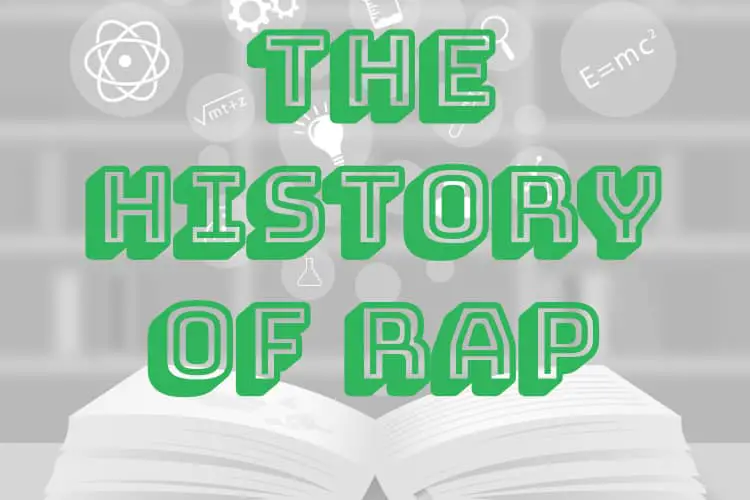
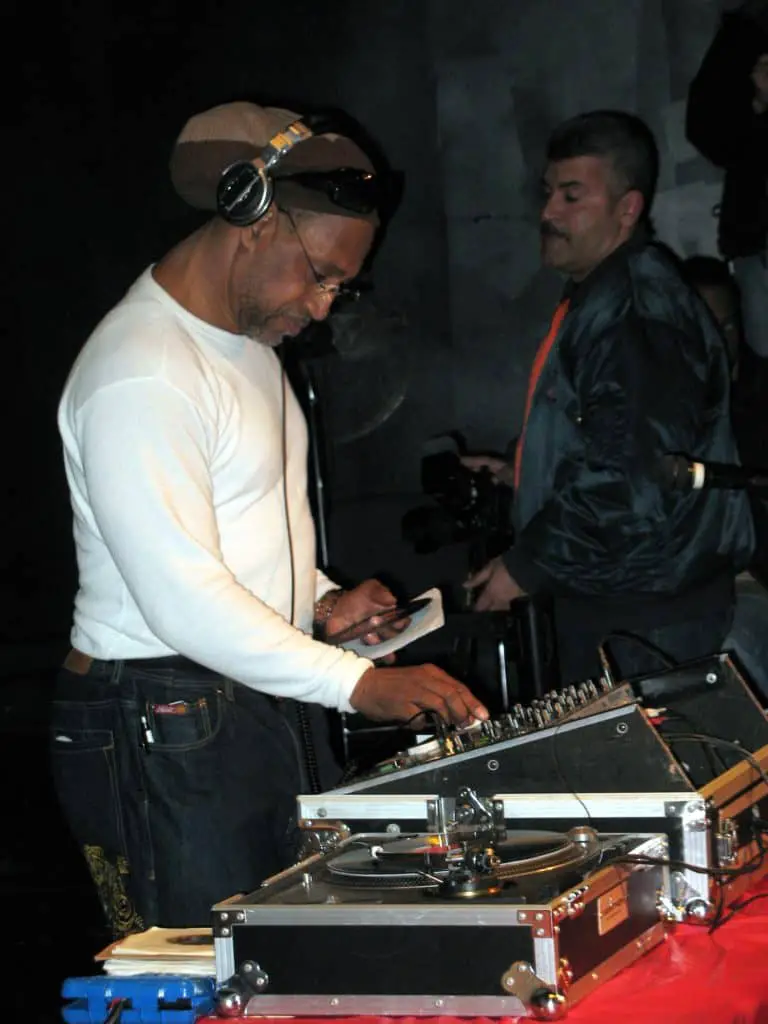

![HERE’S What Happened to the Soul Singer Al Green [2023 Update]](https://performerlife.com/wp-content/uploads/2023/04/what-happened-to-al-green-211x150.jpg)
